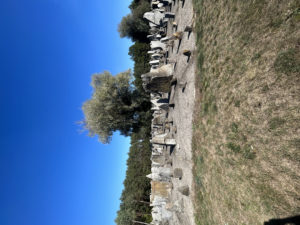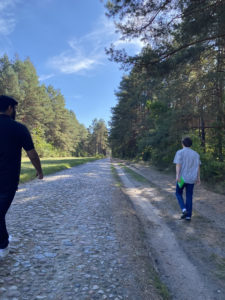Replanting the Tree of Life
By Charlotte Goodman
It’s a beautiful day. You’re walking outside. Listening to the sound of the birds chirping and the gravel shuffle under your feet. Taking a deep breath fills your nose with the smell of freshly cut, maintained grass. Your eyes focus on a butterfly that whizzes past you. As you follow the butterfly’s path, your eyes land on a field of rocks. All different sizes. Suddenly, you hear “…and each rock is supposed to act as a gravestone for each victim murdered in one day. There are 17,000 stones around you.” You’re quickly reminded you’re standing in the site of mass murder.
Growing up in a Jewish household, I was surrounded by symbolism. The most noteworthy, being the use of trees in Jewish scripture and fables. In Judaism, trees symbolize life. For example, the torah, the sacred scroll found in each synagogue, can also be referred to as the Tree of Life because it tells the laws and stories of how a Jew should live their life in a God abiding way. Visual representation of the Tree of Life can be seen at many synagogues around the world. There is also a Jewish holiday named Tu B’Shevat which celebrates the “New Year of the Trees”. In the Torah, there is also mention of the Tree of Wisdom and Tree of Life in the Garden of Eden. Personally though, I was taught in Hebrew School that the Tree of Life is what connects you to all your Jewish ancestors, either living or dead. When you walk into my synagogue you are welcomed with a beautifully displayed Tree of Life. After your Bar/Bat Mitzvah, your name can be added to the synagogue’s Tree of Life, showing your connection to your congregation and those who have come before you.
Perhaps unsurprisingly, Trees figured prominently in Polish-Jewish culture. Even the legend of how Jews settled in Poland is connected to trees. The story goes as follows: when Jews were escaping persecution in western Europe, in a forest they received a sign from heaven with a piece of paper with the word Polin written on it. Polin meant “here you will rest”, which became the name used by Jews to refer to Poland in Hebrew and Yiddish. The permanent exhibition in Polin,
The Museum of the History of Polish Jews, opens with this mystical forest. Here the 1,000 years of Jewish history began. The museum then continues through its different rooms to explain the history of Jewish life. The museum emphasizes how Jewish life has faced continuous hate but continued to thrive and carry on. The Polin museum is a celebration of Jewish life and persistence. This same forest figures hauntingly in the Umschlagplatz memorial down the street. The memorial is located where the station was once was. Here Jews were sent to their deaths, most often to Treblinka. When you approach the Umschlagplpatz memorial, if you take a second to let your eyes wander to the top of the entrance gate, you’ll see a depiction of burnt trees. Polin, the forest, once a haven for Jews, has now burned down. These trees represent the journey back into the forest of Poland, but instead of a journey and story beginning, their story is coming to an end. Inside the memorial, engraved on the wall, there are hundreds of names. Some of these names appear to be Hebrew or Yiddish names, while others seem more Polish, likely given to members of assimilated families. These names themselves are symbolic. The hundreds of names symbolize the hundreds of thousands of Jews that were sent to Treblinka from this station. Many of the victims’ names are unknown, so these names represent every person who walked though these gates. The use of the burning trees is taking the myth of Jews settling in Poland and completely flipping it around to show their near total demise in Poland during the Holocaust, a land they once saw as a new beginning.
Jewish demise started with the repression of Jewish life but escalated into mass murder at extermination and concentration camps. When anticipating a visit to an extermination or concentration camp, one expects to see the shells of buildings, electric fences designed to keep people captive and perhaps remnants of crematoria. None of that exists though at Treblinka. What caught me off guard most was the hauntingly beautiful field that is lined by a sea of trees, planted to cover up the Nazi crimes. In the middle of this clearing is a large memorial with symbolic art representing the former gates, the train tracks, and gas chambers. Originally built as a labor camp, following the Wannsee Conference in Berlin, Treblinka was transformed into the largest of the Operation Reinhard Camps. Operation Reinhard was the program to murder the Jews of occupied Poland. Most Jews were killed in 1942-1943. At Treblinka, an estimated 900,000 people, most of whom were Jews were murdered. Once the regime realized it was losing the war, the Nazis began to cover up their crimes. They burnt down the entire camp, leaving almost no traces behind. They even went as far as to plant new trees and flowers to try and cover up their tracks.
Trees, a symbol of life for Jews, were planted to cover up Nazi atrocities. But the plan did not work. The genocide that took place at Treblinka was uncovered. Today, amidst the nature and beauty, Treblinka serves as a reminder of what happened to the Jews of Europe – how they were murdered, but also how many survived, and continue to survive to this day. Like the Tree of Life in my synagogue, no matter the persecution or hatred Jews face, we stay bonded together, reminding ourselves of the generational connections and love that we share for one another. The Jewish Tree of Life will continue to grow.






